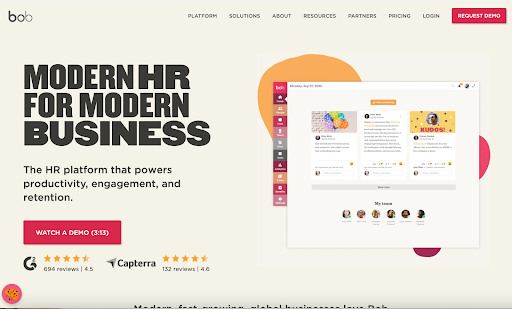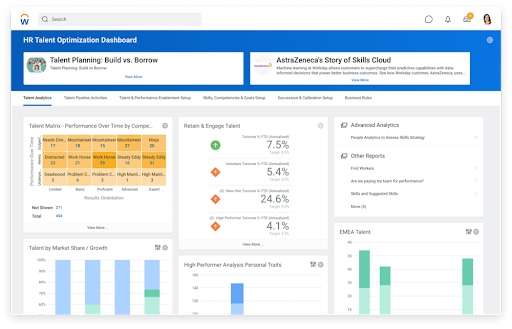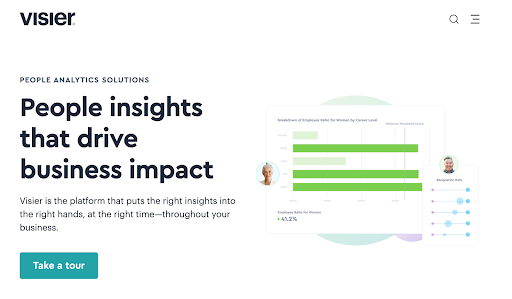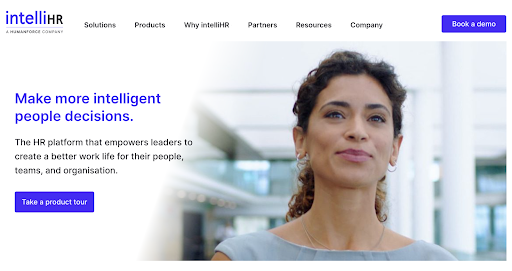A thriving workforce revolves around data. Think about all the people you hire, manage, and develop. Are you sure you have a grip on turnover, employee satisfaction, and retention?
Without HR analytics and its data, you’re managing people in the dark. You’re making knee-jerk decisions – a poor strategy for building a healthy workforce.
It’s why so many businesses turn to HR analytics software. People management tools help HR managers look at the bigger, data-driven picture.
With the right analytics software, you can:
Hire the right people for specific roles
Boost employee engagement, motivation, and retention
Hire better quality talent more frequently
More than 70% of companies are actively investing in people analytics. You risk falling behind the pack if you're part of the 30% that isn't.[1]
Below, we explore what HR data analytics software measures, why it's worth investing in, and the best HR technology to roll out.
Table of contents
- What is HR analytics software?
- Why is people analytics software important to HR professionals?
- The benefits of HR analytics software
- 5 best HR analytics tools
- 5 best practices for leveraging people analytics software in your HR department
- 3 examples of companies succeeding with people analytics software
- Going data-driven? You need HR analytics software
- HR analytics software FAQs
What is HR analytics software?
HR analytics software collects data from applicants and employees to help HR make informed and meaningful workforce planning decisions.
As part of an HR tech stack, analytics software helps managers measure hiring and training effectiveness. It delivers a data-driven overview of applicants entering the business, how workers perform, and where they might need support.
What’s more, HR managers use analytics software to improve employee experience, reduce turnover, and build a more inclusive culture.
What does HR analytics software measure?
HR data analytics software helps you measure metrics like:
Quality-of-hire, based on skills
Offer acceptance rate
Employee turnover, retention, and headcount
Attendance and punctuality
Skills gaps and training needs
Time-to-hire
Performance
Employee satisfaction
Why is people analytics software important to HR professionals?
The need for smarter, more efficient workforce analytics has grown thanks to widening talent gaps, increasing interest in remote and hybrid work, and changes in employee attitudes fueling the Great Resignation.
HR managers want more accessible access to objective employee data to help them lead the way for their workforces. Moreover, they want insights from their people and their behavior to better shape hiring practices and employer branding.
People analytics software gives managers the visibility they need to understand how their workforce performs. It also makes predictions to inform future hiring, upskilling, and reskilling decisions.
For example, by using software with skill assessment integration, HR can track the skills of their hires and analyze which to prioritize when recruiting.
Beyond this, HR analytics software filters and sorts employees based on performance, from attendance and target hitting to project outcomes. Ultimately, data-driven recruiting helps managers decide which workers have the most potential.
The best insights on HR and recruitment, delivered to your inbox.
Biweekly updates. No spam. Unsubscribe any time.
The benefits of HR analytics software
Used effectively, HR data analytics software:
Improves hire quality
Speeds up the hiring process
Improves the employee and candidate experience
Increases retention
Let’s explore why and how.
1. Improves hire quality
HR managers use software to pick out common traits between high-performing employees. For instance, they could find that engineers with the best project outcomes have strong critical thinking skills.
Recruiters use software to pinpoint which hiring channels produce the best-performing workers, meaning they prioritize listing roles there in the future.
Software data helps support people in identifying genuine talent. Research shows that manual interview scoring only correlates with quality-of-hire 9% of the time. You need objective data to bolster your decision-making.
2. Speeds up the hiring process
People analytics software is helpful as a starting point for data-driven decision-making regarding HR technology trends in general.
Data pulled during recruitment helps recruiters decide if automation and artificial intelligence (AI) could reduce significant time-to-hire and onboarding tasks.
Such data insights could support a decision to install HR chatbots, keeping applicants engaged and informed while moving them efficiently through the interviewing process.
Consider Google's recruitment process. Using software to become more data-driven, the company removed the need to interview after a fourth round because it proved unnecessary and time-consuming.[2]
3. Improves employee and candidate experience
Improving candidate experience is an important talent acquisition trend, and for retention, so is employee experience.
Software for HR analytics pools satisfaction scoring and surveys into visual reports and graphs. Therefore, managers find it easier to understand what their workforce demands at every level.
What’s more, talent acquisition analytics software tracks drop-offs and "ghosting" during applications, showing where potential hires leave.
For instance, they might fail to appear for an interview or stop answering emails between interviews and final checks.
Software data helps recruiters decide whether or not to reduce time spent before interviews or automate processes to keep applicants captivated.
Finally, analytics software uses employee pulse surveys and in-house rating data to produce clear reports on how and why workers might feel unsupported. Tying blind surveying to such systems helps to keep data honest and objective.
4. Increases retention
Companies usually work on improving retention rates by finding worker frustration points and informing HR managers on how to fix them. Of course, this depends largely on what’s driving turnover in the first place.
Data shows that 70% of US turnover is voluntary, meaning most of your workers leave by choice, and there's a good chance you're losing talented people for preventable reasons. The gap between hiring and firing rates has remained needlessly close in recent years, too:
Software for HR analytics can run predictive turnover analytics based on real-time data. This key feature helps managers to target specific employee flight risks and build specific retention programs. For instance, data analyses of employee lifecycles could show that staff in a particular team leave regularly because of a lack of progression.
Retaining employees and minimizing attrition are some of the most critical aspects of HR analytics – read our complete guide linked for a deep dive.
5 best HR analytics tools
Having explored the why behind HR data analytics tools, let’s tap into how to get started.
We researched the most popular analytics software for HR professionals on the market and reviewed our top five picks below.
Factors we considered
When researching and comparing the best people analytics software, we prioritized the following:
Cost and value
Ease of use
Third-party software integration
Reporting capabilities
Specialty uses
Customization
Use these factors purely as a guide. You should always prioritize your individual needs and goals when researching software solutions to invest in.
Moreover, take any promises of "free HR analytics software" or "free HR analytics tools" with a pinch of salt. Look for free trials, but remember you must always invest some capital for the best data insights.
Let’s explore our best HR analytics software picks with a quick summary followed by our reviews.
Best HR data analytics tools: In brief
Tool | Pros | Cons |
1. HiBob | - Simplifies data from several different data sources - Easy to view different workforces, HR metrics, and custom KPI reports at a glance | - The mobile app is more restrictive than the desktop build - Some features – such as feedback and recognition – are lightweight compared with competitors |
2. Workday | - Highly scalable with few limitations - Uses HR automation to reduce manual insight | - Some users claim it’s expensive compared with other tools - Customization has a tricky learning curve |
3. BambooHR | - Consolidates several HR tools into one - Easy to train on and use | - Some users struggle with third-party integrations - Can take time and effort to roll out |
4. Visier | - Built with retention strategy in mind - One of the fastest data reporters | - Lacks some flexibility compared with other tools - Some users find the product to be limited |
5. intelliHR | - One of the most flexible and customizable analytics tools - Useful employee self-service options available | - Some users feel the software is restricted in aspects of functionality and integration - Missing some features that its competitors use |
1. HiBob: Most user-friendly analytics software
HiBob is a business intelligence tool and HRIS system recommended by us here at TestGorilla. It’s a refreshingly simple and intuitive people management tool we use during recruitment and beyond.
The software collates data from multiple workforces into one user-friendly platform, pulling data across different applications and sources. It's built with the "everyday user" in mind, meaning you don't need to hire data experts to unleash its benefits.
The program supports multiple HR dashboards to track different KPIs, enabling you to create custom data visualizations to track absenteeism, skill gaps, and retention trends.
Rating: 4.5 stars out of five (G2, 724 reviews)
Pricing at time of writing: Pricing available on request
2. Workday: Best for AI analytics
Workday HCM is a single-point cloud-based analytics engine. One of its most appealing features is its machine learning skills matcher – which helps you to align recruits more easily to job roles.
A leader in AI in HR, the software uses “augmented analytics,” where its engine suggests data insights and contexts you could otherwise miss.
The tool is easy to scale with your business as your needs evolve and expand.
Rating: Four out of five stars (G2, 1,295 reviews)
Pricing at time of writing: Pricing available on request
3. BambooHR: Best for onboarding data
BambooHR’s user-friendly analytics software, much like HiBob, focuses on consolidating as much complex data as possible.
However, one of the software's most exciting features is its onboarding focus. The program grants a one-page snapshot of each employee, summarizing their roles, pay, and benefits. It's easy to transfer applicants with specific needs into their own profiles to refer to at a glance.
This suite removes the need for several external applications, such as payroll software, which comes packaged into an all-in-one system.
Rating: 4.5 out of five stars (G2, 1,815 reviews)
Pricing at time of writing: Pricing available on request
4. Visier: Best for retention strategies
Visier pivots toward employee retention and management empowerment tools to help your HR team assess risks, spot opportunities, and use insights with less effort.
The software gives professional guidance with a powerful question-and-answer service that analyzes your data. Out-of-the-box functionality is exceptional, with many users referring to the program as a “just add people” system.
The program is also popular for its efficient talent analytics and industry benchmarking, helping HR managers access insightful data in minutes rather than waiting for days.
Rating: 4.5 stars out of five (G2, 121 reviews)
Pricing at time of writing: Pricing available on request
5. intelliHR: Best for tool integration
Many HR analytics systems offer program integration as standard, but intelliHR makes it its focus.
This all-in-one people manager enables you to create your own HR ecosystem from scratch using existing tools, such as applicant tracking systems.
The software offers a scalable and customizable HR data tracking system that becomes more useful with the more data points you feed it. The software makes it easy to move integrations in and out, meaning you can change your datasets quickly.
This talent management tool offers automation, too, saving you more time and effort on mundane tasks.
Rating: Five stars out of five (G2, 87 reviews)
Pricing at time of writing: Pricing available on request
5 best practices for leveraging people analytics software in your HR department
Choosing a top HR analytics tool is just the start of embracing data-driven recruitment.
Here are five tried and tested tips to help you make the most of all that people data.
How to use tools for HR analytics: A summary
Best practice | Brief summary |
1. Build short- and long-term goals to make the most of your software | Create tangible questions and goals you’d like analytics to answer before investing to avoid wasting time and money |
2. Identify data sources and gaps as a priority | Ensure you have clean and accessible data for software to build useful impressions |
3. Hire a data expert to manage your analytics | Recruit specialists to arrange spreadsheets, build datasets, and create insights to save time and effort |
4. Focus on predictive analytics and drive positive change | Use software that suggests remedies to potential issues so you can make changes to meet goals in real-time |
5. Support hiring and training decisions by integrating talent assessments | Use analytics findings to test for specific skills during recruitment and decide which to prioritize |
1. Build short- and long-term goals to make the most of your software
To understand whether or not HR analytics software is worth your time and investment, set clear goals on how you intend to use it.
These goals could be short- or long-term. However, they must be tangible and measurable with your prospective software in mind.
For instance, as a short-term goal, you could use your analytics alongside performance management software to measure employees over a few months and check for correlations between skills and outcomes.
You could then use analytics software to track who leaves your company and why in the long term by combining staff survey templates with exit data.
There's no point investing in analytics software until you have precise questions you want to ask and until you're willing to make changes based on its actionable insights.
2. Identify data sources and gaps as a priority
Your people analytics software is only so effective depending on the data you feed it. Therefore, collating which data sources are most important to you is wise before building an HR system.
Programs like intelliHR are helpful here because you can build custom ecosystems based on the tools and datasets you already use. However, when deciding which questions you'd like software to answer, ensure you have the relevant raw data available.
Now’s a good time to check for data gaps. Not all data management tools help you fill in missing details, and when you start using analytics software with incomplete datasets, you risk inaccurate reporting and confusing advice.
You could, however, use other programs to pull and sort information for you. For instance, consider using machine learning in HR datasets to search, sort, and export to analytics.
3. Hire a data expert to manage your analytics
Again, you can only expect analytics software to do so much for you. Software such as Visier arrives with user-friendly tools and human advice, but managing waves of information and building strategies isn't always easy unless you're a data expert.
So, consider hiring a data expert or a team to source, track, collect, and interpret data for you. Doing so saves time, effort, and, therefore, money.
Start by building an ICP for a data expert on your company’s goals and skills required for such a role.
For instance, you might want to test for specific skills such as Data Analytics in Google Cloud Platform (GCP). There’s a dedicated assessment available through TestGorilla:
If you want to hire data experts, it's wise to test their competency with multiple software options and their attention to detail.
4. Focus on predictive analytics and drive positive change
Predictive analytics builds confident forecasts of what could happen in the future. That doesn’t just mean a future based on the status quo if you choose different strategies and take risks.
This type of advanced analytics is a reliable driver for positive change. A potentially negative forecast shows you that action is needed to escape disaster. The best analytics software shows you how to avoid that fate – and provides you with reports so you understand how to move ahead.
Use predictive analytics in real time to ensure you're on track. For example, if you roll out employee benefits to boost engagement, your software can advise your retention rate in six months. By regularly pulling reports, you see how this prediction changes from week to week.
5. Support hiring and training decisions by integrating talent assessments
Many analytics tools help you integrate custom skill assessments into their software to help make hiring, training, and lateral mobility more accurate and effective.
So, you could use BambooHR to integrate assessments from TestGorilla and track the results through report summaries. Alternatively, you could feed test results data into an analytics tool and use them to inform future hiring decisions.
Following a skills gap analysis, you could also ask analytics software to report on skills test results for desirable traits your company is missing.
Using skills data helps you rely on objective information to make more confident, reliable decisions.
Analytics software can help you visualize and organize it, so decision-making is easier, more efficient, and more reliable than guesswork.
Used alongside candidate assessment software, you're working with empirical data that are actionable and easy to understand.
3 examples of companies succeeding with people analytics software
There are plenty of companies making the most out of people analytics, and here are three to take inspiration from:
eBay
Airtable
END.
1. eBay
Online auction giant eBay relied on a fresh analytics approach to help understand its employees better. The company sought out the Visier People: Organization tool to help break down company demographics and key worker statistics.
The web auctioneer found new ways to enhance worker engagement and performance, and with analytics, even saved millions of dollars by reducing employee turnover rates by a few percent.
The brand now uses analytics software to break down each stage of the employee journey – by producing development plans, designing compensation packages, and tailoring benefits.
The aftereffect is employees stay longer, and the company saves considerable money.
2. Airtable
Workflow management provider Airtable easily manages its workflows thanks to insights from Workday, such as through its extensive automation service.
However, the analytics platform also helps the company reduce time, costs, and effort by consolidating mass data and disparate sources into a system everyone can refer to and understand.
Moving to streamlined HR analytics has helped the firm connect its people and financial data seamlessly. It runs a highly scalable system that's already saving money otherwise spent on manual checks and measures.
3. END.
END., a European apparel and homeware label, benefits from BambooHR to help improve its access to employee data. Before using the service, the label found its HR data management too complex and challenging to scale with its growth.
Rolling out a new analytics program enabled the brand to communicate clearly with staff and easily manage complex documents. Greater visibility meant the company could now produce more confident and reliable reports and make decisions based on objective data.
The move has helped the firm condense meetings into self-service forms, saving considerable time and effort and improving the employee experience.[3]
Going data-driven? You need HR analytics software
Without HR analytics software, you risk losing sight of what matters most to your employees and, in return, your company.
It’s the future of HR technology – you need data to measure your performance and to help make positive changes.
The best HR analytics tools collect complex data and visualize it to support confident decision-making. Instead of constantly guessing what’s best for your business, you can use software to:
Track where your best hires are coming from
Help improve candidates’ experiences
Save time on costly processes
Appear more appealing to prospects
However, it’s not the only software you should add to your tech stack. Think about upping your training game with learning management systems, too – with help from our guide.
Want to learn more about how TestGorilla’s skill assessments support data-driven recruiting?
Try out our demo or test-drive our software by registering for a free account!
HR analytics software FAQs
Let’s close with some quick, common questions regarding people analytics software.
What is HR data analytics?
HR data analytics is the sourcing and analysis of employee and candidate information. It's the breakdown of employee performance, skills, and time-to-hire data.
HR managers and recruiters use analytics to improve their strategies – hiring better employees, retaining more talent, and reducing hiring time and costs.
What is the difference between HRIS and HR analytics?
An HRIS, or Human Resources Information System, collects and manages complex information companies hold on their applicants and employees. It’s a repository that helps to consolidate large amounts of data.
HR analytics, meanwhile, helps users break down this data by producing reports and insights they use to help shape their recruitment and people management strategies.
Is HR analytics difficult to study?
Becoming an expert in HR analytics takes time and dedication. However, tools for HR analytics make it easier for managers and recruiters to access workforce data and make informed decisions.
Some software, such as HiBob and BambooHR, helps to simplify complex information into visual dashboards and reports, making it easier for data novices to understand. Look at our review of the best HR analytics software to learn more.
What are the four types of HR analytics?
The four main types of HR analytics are predictive, descriptive, diagnostic, and prescriptive:
HR predictive analytics tools use data to forecast what might happen in the future
Descriptive analytics looks at past data and puts together insightful patterns
Diagnostic analytics uses data to help answer specific questions regarding ongoing problems
Prescriptive analytics offers recommendations
Sources
Enderes, Kathi; Shannon, Matthew. (2019). “People Analytics Solutions: Market Primer”. Deloitte. Retrieved January 20, 2024. https://www2.deloitte.com/content/dam/Deloitte/us/Documents/human-capital/us-human-capital-bersin-lt-people-analytics-solutions-market-primer.pdf
Bennett, Carl. (February 27, 2015). “HR and people analytics: Stuck in neutral”. Deloitte. Retrieved January 20, 2024. https://www2.deloitte.com/uk/en/insights/focus/human-capital-trends/2015/people-and-hr-analytics-human-capital-trends-2015.html/
“Meet Kirsty McDaid”. (April 23, 2023). BambooHR. Retrieved January 21, 2024. https://www.bamboohr.com/customers/end
You've scrolled this far
Why not try TestGorilla for free, and see what happens when you put skills first.





















